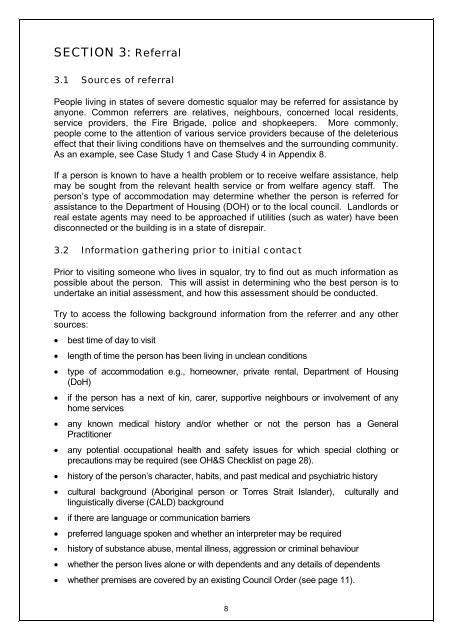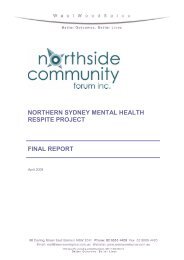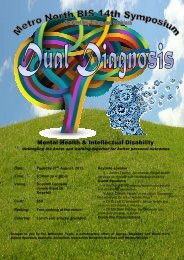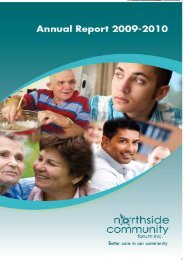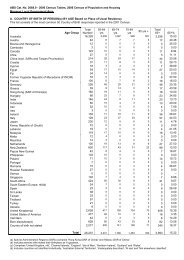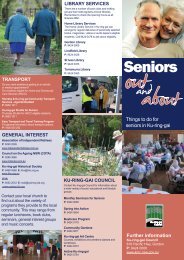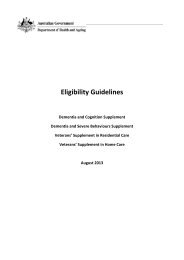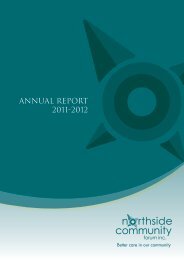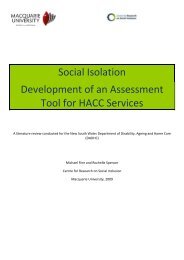Guidelines for field staff to assist people living in ... - Housing NSW
Guidelines for field staff to assist people living in ... - Housing NSW
Guidelines for field staff to assist people living in ... - Housing NSW
Create successful ePaper yourself
Turn your PDF publications into a flip-book with our unique Google optimized e-Paper software.
SECTION 3: Referral3.1 Sources of referralPeople <strong>liv<strong>in</strong>g</strong> <strong>in</strong> states of severe domestic squalor may be referred <strong>for</strong> <strong>assist</strong>ance byanyone. Common referrers are relatives, neighbours, concerned local residents,service providers, the Fire Brigade, police and shopkeepers. More commonly,<strong>people</strong> come <strong>to</strong> the attention of various service providers because of the deleteriouseffect that their <strong>liv<strong>in</strong>g</strong> conditions have on themselves and the surround<strong>in</strong>g community.As an example, see Case Study 1 and Case Study 4 <strong>in</strong> Appendix 8.If a person is known <strong>to</strong> have a health problem or <strong>to</strong> receive welfare <strong>assist</strong>ance, helpmay be sought from the relevant health service or from welfare agency <strong>staff</strong>. Theperson’s type of accommodation may determ<strong>in</strong>e whether the person is referred <strong>for</strong><strong>assist</strong>ance <strong>to</strong> the Department of Hous<strong>in</strong>g (DOH) or <strong>to</strong> the local council. Landlords orreal estate agents may need <strong>to</strong> be approached if utilities (such as water) have beendisconnected or the build<strong>in</strong>g is <strong>in</strong> a state of disrepair.3.2 In<strong>for</strong>mation gather<strong>in</strong>g prior <strong>to</strong> <strong>in</strong>itial contactPrior <strong>to</strong> visit<strong>in</strong>g someone who lives <strong>in</strong> squalor, try <strong>to</strong> f<strong>in</strong>d out as much <strong>in</strong><strong>for</strong>mation aspossible about the person. This will <strong>assist</strong> <strong>in</strong> determ<strong>in</strong><strong>in</strong>g who the best person is <strong>to</strong>undertake an <strong>in</strong>itial assessment, and how this assessment should be conducted.Try <strong>to</strong> access the follow<strong>in</strong>g background <strong>in</strong><strong>for</strong>mation from the referrer and any othersources:• best time of day <strong>to</strong> visit• length of time the person has been <strong>liv<strong>in</strong>g</strong> <strong>in</strong> unclean conditions• type of accommodation e.g., homeowner, private rental, Department of Hous<strong>in</strong>g(DoH)• if the person has a next of k<strong>in</strong>, carer, supportive neighbours or <strong>in</strong>volvement of anyhome services• any known medical his<strong>to</strong>ry and/or whether or not the person has a GeneralPractitioner• any potential occupational health and safety issues <strong>for</strong> which special cloth<strong>in</strong>g orprecautions may be required (see OH&S Checklist on page 28).• his<strong>to</strong>ry of the person’s character, habits, and past medical and psychiatric his<strong>to</strong>ry• cultural background (Aborig<strong>in</strong>al person or Torres Strait Islander), culturally andl<strong>in</strong>guistically diverse (CALD) background• if there are language or communication barriers• preferred language spoken and whether an <strong>in</strong>terpreter may be required• his<strong>to</strong>ry of substance abuse, mental illness, aggression or crim<strong>in</strong>al behaviour• whether the person lives alone or with dependents and any details of dependents• whether premises are covered by an exist<strong>in</strong>g Council Order (see page 11).8


